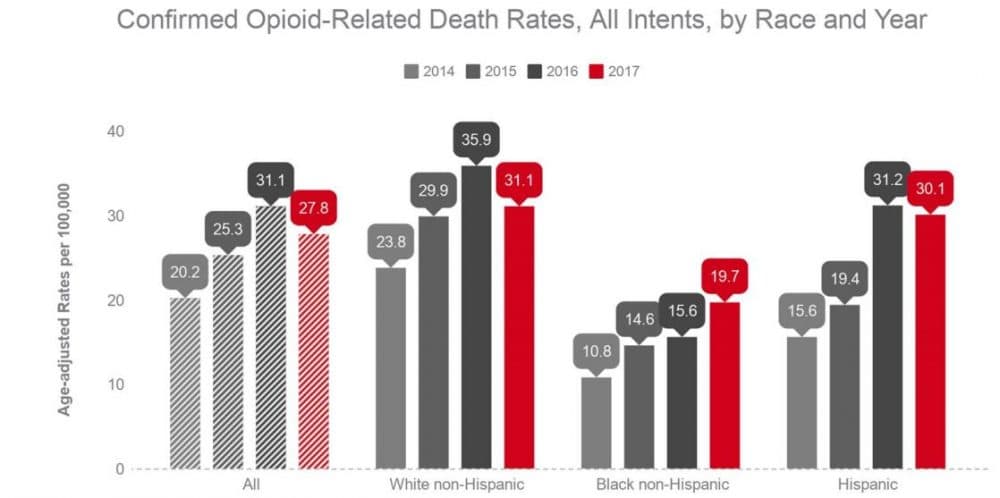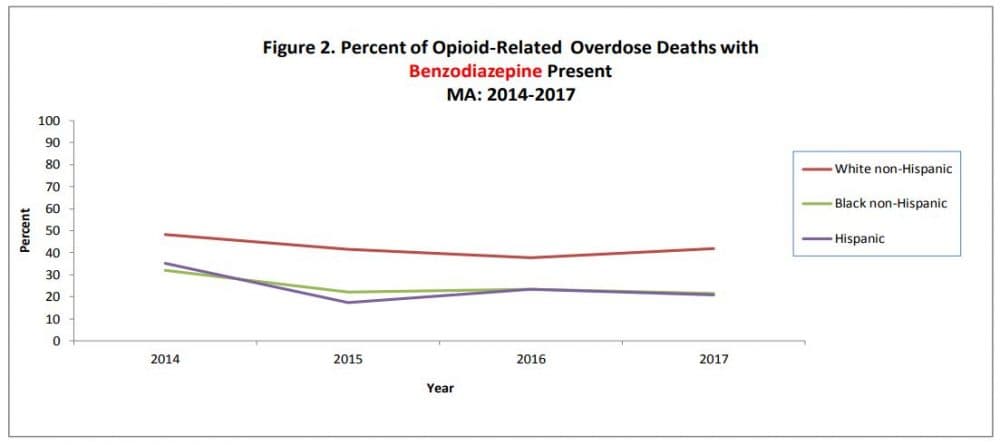Advertisement
Opioid Death Rate Declined In Mass. In 2017 — Except For Blacks
The recent decline in opioid overdose deaths in Massachusetts appears to have continued into this year.
Preliminary numbers out Tuesday from the state Department of Public Health (DPH) show 5 percent fewer deaths in the first three months of 2018, as compared with the same period in 2017.

Fentanyl is still the main suspected cause of death. It was present in 85 percent of all opioid-related deaths in 2017.
And the state estimates that 133 fewer people died of overdoses in 2017 than in 2016.
Why is tough to answer. More naloxone — brand name Narcan — seems to be part of the answer, because the total number of overdoses tracked by EMS didn't change much: 22,107 in 2017 and 22,417 in 2016.
DPH Commissioner Monica Bharel says prevention and education, a 30 percent drop in opioid prescriptions, and the shift to seeing addiction as a treatable disease are also part of the story.
"I have seen in the last three years or so an unbelievable shift in the way that we as a state look at opioid use disorder," Bharel said. "That is so hopeful and encouraging and I know together we can bend this opioid epidemic death curve, because there are really too many people dying from this disease."
The curve is not bending for blacks; for them, it's still rising:

Blacks say they are less likely to call 911 because they don't trust law enforcement. They also tend to have less access to treatment.
And fentanyl is showing up in cocaine, which the state report shows is present in more Latino and black opioid overdose deaths than among whites:

It's not clear how often the two drugs are being used together intentionally, in a super-lethal speedball, or how many of these deaths are cocaine users who didn't realize their drug was laced with fentanyl. Some drugs users and law enforcement officials worry cocaine-laced fentanyl could trigger a new wave in the opioid epidemic.
This is the first time the state has drilled down on drugs present at the time of death, by race. Here's another revelation: Last year, whites were twice as likely to be using a benzodiazepine, like Klonopin or Xanax, when suffering a fatal overdose than were Latinos or blacks.

Also for the first time, Massachusetts is posting overdoses by location, as well as by a user's residence.
In Boston, for example, 266 men and women died after an overdose in the city last year, but only 187 of them were residents. That would support the claim of city leaders that Boston shoulders an unfair burden in fighting the epidemic.
But if you look at the total number of overdoses in Boston -- not just deaths -- the city in 2017 handled 2,646, or 11.9 percent of the state total. That's a little more than Boston's 9.8 percent share of state residents, but not a disproportionate burden.
